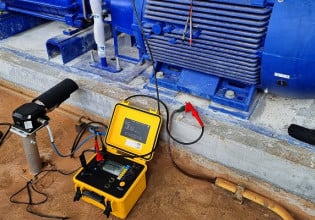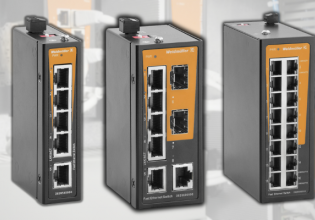Introduction to Conveyor Belt Systems
Who created the first conveyor system, what are some common types of conveyor systems used in industrial automation, and what are the types of controls involved?
What is a Conveyor Belt System?
Conveyor systems are mechanical structures that transport material from one location to another. It consists of drive mechanisms such as motors to move a transport material, commonly a belt. The material is carried by the belt and follows the belt movement to move to the target location. Additional components can include chains, rollers, pulleys, and wheels.

Figure 1. A pulley conveyor belt system. Image used courtesy of OSHA
Conveyor belt systems are common in factories where the transportation of goods between different departments or areas is required for the plant’s operation to proceed. For example, a conveyor belt may transport a container from filling machines to the packaging machine in the packaging department.
A History of Conveyor Systems
The conveyor systems were first developed in 1892 by Thomas Robins for the coal industry. The main idea behind this invention was to assist material movement with minimum or zero human involvement. In 1901, Swedish Company Sandvik invented steel conveyor systems. The steel conveyor systems helped industries use conveyors in stressed and complicated operations, which was lacking in its initial design by Thomas Robins.
_-_BEIC_6328731.jpeg)
Figure 2. One of the first long belt conveyor systems, located in Milan. Image used courtesy of Paolo Monti [CC BY-SA 4.0]
Richard Sutcliffe invented a conveyor belt in 1905, designed especially for mines. These belts could function in underground areas to transport coal and other minerals.
In 1913, conveyors were first used in the manufacturing industry when Henry Ford introduced conveyor belts in the assembly lines of Ford Motor Company. Then, a special conveyor system with a half twist, called the Turnover Conveyor Belt System, was developed in 1957 by the B. F. Goodrich Company.
Since 1957, several other conveyor systems have been implemented throughout factories worldwide.
Types of Conveyor Systems
Let’s look at a few common types of conveyor systems being used in industries.
Belt Conveyor System
A belt conveyor uses a belt to transport material from one point to another. The belt is stretched across the conveyor length with pulleys at both ends to support the belt. A driving mechanism such as an electric motor rotates the pulleys, which moves the belt across the conveyor length. The belt’s speed can be fixed or variable, depending upon the application required.

Figure 3. A belt conveyor. Image used courtesy of Ultimation Inc.
A conveyor belt is commonly used and is a generally less expensive option. Industrial environments can use it for most material transportation applications. The belt’s construction material varies depending on the transported material characteristics, area requirements, and operations.
Roller Conveyor
The roller conveyor uses multiple rollers instead of a belt. The rollers can move when manual force is applied, or if the material exerts pressure on it. Rollers can also move through the force of gravity when the conveyor is slanted downward.
Each roller moves independently of other rollers with a bearing on one or both ends to rotate smoothly. Or, a bearing can be used on one end with a sprocket at another end. They move bulk goods because the roller material can withstand high stress and force caused by heavy goods.
Figure 4. A motorized roller conveyor system. Video used courtesy of Dematic
Another category of roller conveyor is called powered roller conveyor. It uses motorized rollers and involves less manual or human effort to move. These types are useful for highly automated facilities.
Bucket Conveyor System
A bucket conveyor uses a series of containers (or buckets) to transport material. The containers are attached to belts or chains that drive the buckets. The main feature of this conveyor is that the containers remain upright until discharged, regardless of whether they are used in a horizontal, slanted, or vertical system.
Controls Used in Conveyor Belt Systems
As with other machines, conveyor systems do not rely only on mechanical components or parts. Electrical and electronic instrumentation is widely used to control conveyor systems. Following are some common components used to control conveyor belt systems.
VFDs and motors: Motors are commonly used as a drive mechanism for all types of conveyor systems. The motor operates with the help of variable frequency drives (VFDs). The VFD controls the motor and provides power to operate. It also offers specialized functions to effectively carry out conveying applications, such as preventing opposite conveyor movement or increasing/decreasing motor speed.
Proximity sensors: Proximity sensors synchronize the conveyor system operation with other systems and machines. They detect when a material is present to start or stop the conveyor (i.e., it stops the conveyor when the material is not at the feed side and starts the conveyor when the material reaches the feeding side.

Figure 5. Proximity sensors. Image used courtesy of Pepperl+Fuchs
The proximity sensor can also signal next-level equipment, such as a cartoning machine, to start operating when the material reaches it.
Controllers and human-machine interfaces (HMIs): The main controller and HMI control the conveyor system operation. They allow the operator to set different function modes (such as automatic or manual operation), increase or decrease the conveyor speed through the motor, and help manage alarm conditions.
Conveyor systems have become an important and irreplaceable component in various industries, especially in the manufacturing industry. They can transfer material without human involvement and be used in operations where human involvement is strictly prohibited. For example, in food and pharmaceutical product filling operations, the material is transferred to the filling station through conveyor systems.
Conveyor systems also help transfer bulky material over long distances in warehouses, enabling heavy material to be moved in less time and increasing material safety. In the coming weeks, we’ll cover maintenance strategies, upcoming smart conveyor systems, and how to calculate belt speed.
Interested in more conveyance system content?
- What Makes a Smart Conveyor System “Smart”?
- Calculating the Speed of a Conveyor System
- Conveyor Belt Maintenance Strategies
- VSD and VFD Motor Drive Features






